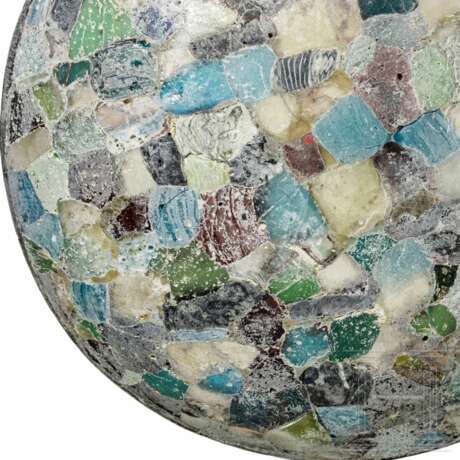ID 658963
Lot 814 | Mosaikglas-Schale, römisch, 1. Jhdt. v. Chr. - 1. Jhdt. n. Chr.
Estimate value
€ 1 000
The double-walled bowl shaped like a segment of a ball. The bowl is composed of two translucent vessels fitting one inside the other, a brownish glass rod with a white spiral thread applied to the rims. This embellishment is fully consistent with comparable borders found on Hellenistic and early Roman mosaic bowls. There is a pigment coating between the two walls, presumably applied to the outer surface of the inner bowl in similar fashion to Hellenistic gold glasses. The patterns were created by etching parts of the pigment layer.
An undulating tendril with leaves in the wave troughs and crests running around the bowl. The bowl obviously shattered into large fragments at some point, reassembled without losses to the material. Moisture has penetrated between the two walls along the break lines and cracks, making these areas appear darker in places. However, the floral pattern can be clearly distinguished all over when held against the light.
An exceptionally rare, intricately made deluxe glass from the late-Hellenistic to the early-Roman epoch. Diameter 10.4 cm, height 3.8 cm.
Provenance: From the collection of a South German classical philologist, acquired by him during the 1950s and 1960s. Remaining thereafter in the family estate.
Condition: II -
Glasschale mit floralem Dekor in Pigmentschicht zwischen doppelter Wandung, späthellenistisch - frührömisch, 1. Jhdt. v. – 1. Jhdt. n. Chr.
Doppelwandige Schale in Form eines Kugelsegments. Die Schale besteht aus zwei genau ineinanderpassenden, transluziden Gefäßen, denen am Rand ein bräunlicher Glasstab mit weißen Spiralfäden aufgesetzt worden ist. Diese Gestaltung entspricht völlig gleichartigen Rändern bei hellenistischen und frührömischen Mosaikschalen. Zwischen den beiden Wandungen befindet sich eine Pigmentschicht, die wohl ähnlich wie bei hellenistischen Goldgläsern auf der Außenseite der inneren Schale aufgetragen worden ist. Die Muster wurden durch Radierung von Teilen der Pigmentschicht erzeugt.
Rings um die Schale verläuft eine Wellenranke mit Blättern in Wellentälern und -bergen. Die Schale ist in größere Scherben zerbrochen gewesen, wurde aber ohne Fehlstellen wieder zusammengesetzt. Entlang von Bruchkanten oder Rissen konnte Feuchtigkeit zwischen die beiden Wandungen dringen, sodass die Flächen partiell dunkler erscheinen. Das florale Muster hebt sich jedoch gegen das Licht gehalten überall gut ab.
Ausgesprochen seltenes und aufwendig hergestelltes Luxusglas der späthellenistischen bis frührömischen Epoche. Durchmesser 10,4 cm, Höhe 3,8 cm.
Provenienz: Aus der Sammlung eines süddeutschen Altphilologen, von diesem erworben in den 1950er und 1960er Jahren. Dann weiter in Familienbesitz.
Zustand: II -
| Place of origin: | Roman Empire |
|---|
| Place of origin: | Roman Empire |
|---|
| Address of auction |
Hermann Historica Bretonischer Ring 3 85630 Grasbrunn / München Germany | ||||||||||||||
|---|---|---|---|---|---|---|---|---|---|---|---|---|---|---|---|
| Preview |
| ||||||||||||||
| Phone | +49 (0)89 5472 649 0 | ||||||||||||||
| Fax | +49 (0)89 5472 64999 | ||||||||||||||
| Buyer Premium | 25 % | ||||||||||||||
| Conditions of purchase | Conditions of purchase | ||||||||||||||
| Business hours | Business hours
|







